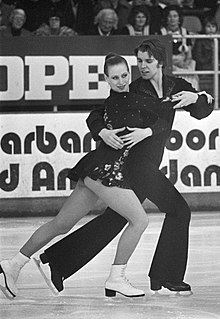
Back Ysdans Afrikaans الرقص على الجليد Arabic الرقص على الجليد ARZ Isdans Danish Eistanz German Danza sobre hielo Spanish Jäätants Estonian رقص روی یخ Persian Jäätanssi Finnish Danse sur glace French
 Ice dance in 1976, its first year as an official Olympic sport (Irina Moiseeva and Andrei Minenkov) | |
| Highest governing body | International Skating Union |
|---|---|
| Characteristics | |
| Team members | Duos |
| Mixed-sex | Yes |
| Equipment | Figure skates |
| Presence | |
| Olympic | Part of the Winter Olympics from 1976 |
Ice dance (sometimes referred to as ice dancing) is a discipline of figure skating that historically draws from ballroom dancing. It joined the World Figure Skating Championships in 1952, and became a Winter Olympic Games medal sport in 1976. According to the International Skating Union (ISU), the governing body of figure skating, an ice dance team consists of one woman and one man.[1]
Ice dance, like pair skating, has its roots in the "combined skating" developed in the 19th century by skating clubs and organizations and in recreational social skating. Couples and friends would skate waltzes, marches, and other social dances. The first steps in ice dance were similar to those used in ballroom dancing. In the late 1800s, American Jackson Haines, known as "the Father of Figure Skating",[2] brought his style of skating, which included waltz steps and social dances, to Europe. By the end of the 19th century, waltzing competitions on the ice became popular throughout the world. By the early 1900s, ice dance was popular around the world and was primarily a recreational sport, although during the 1920s, local skating clubs in Britain and the U.S. conducted informal dance contests. Recreational skating became more popular during the 1930s in England.
The first national competitions occurred in England, Canada, the U.S., and Austria during the 1930s. The first international ice dance competition took place as a special event at the World Championships in 1950 in London. British ice dance teams dominated the sport throughout the 1950s and 1960s, then Soviet teams up until the 1990s. Ice dance was formally added to the 1952 World Figure Skating Championships; it became an Olympic sport in 1976. In the 1980s and 1990s, there was an attempt by ice dancers, their coaches, and choreographers to move ice dance away from its ballroom origins to more theatrical performances. The ISU pushed back by tightening rules and definitions of ice dance to emphasize its connection to ballroom dancing. In the late 1990s and early 2000s, ice dance lost much of its integrity as a sport after a series of judging scandals, which also affected the other figure skating disciplines. There were calls to suspend the sport for a year to deal with the dispute, which seemed to affect ice dance teams from North America the most. Teams from North America began to dominate the sport starting in the early 2000s.
Before the 2010–11 figure skating season, there were three segments in ice dance competitions: the compulsory dance (CD), the original dance (OD), and the free dance (FD). In 2010, the ISU voted to change the competition format by eliminating the CD and the OD and adding the new short dance (SD) segment to the competition schedule. In 2018, the ISU voted to rename the short dance to the rhythm dance (RD).
Ice dance has required elements that competitors must perform and that make up a well-balanced ice dance program. They include the dance lift, the dance spin, the step sequence, twizzles, and choreographic elements. These must be performed in specific ways, as described in published communications by the ISU, unless otherwise specified. Each year the ISU publishes a list specifying the points that can be deducted from performance scores for various reasons, including falls, interruptions, and violations of the rules concerning time, music, and clothing.